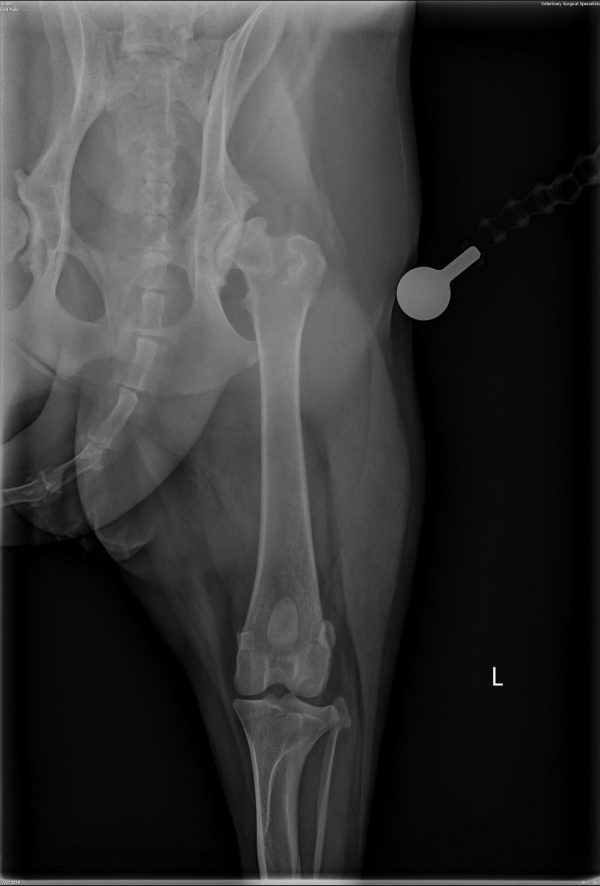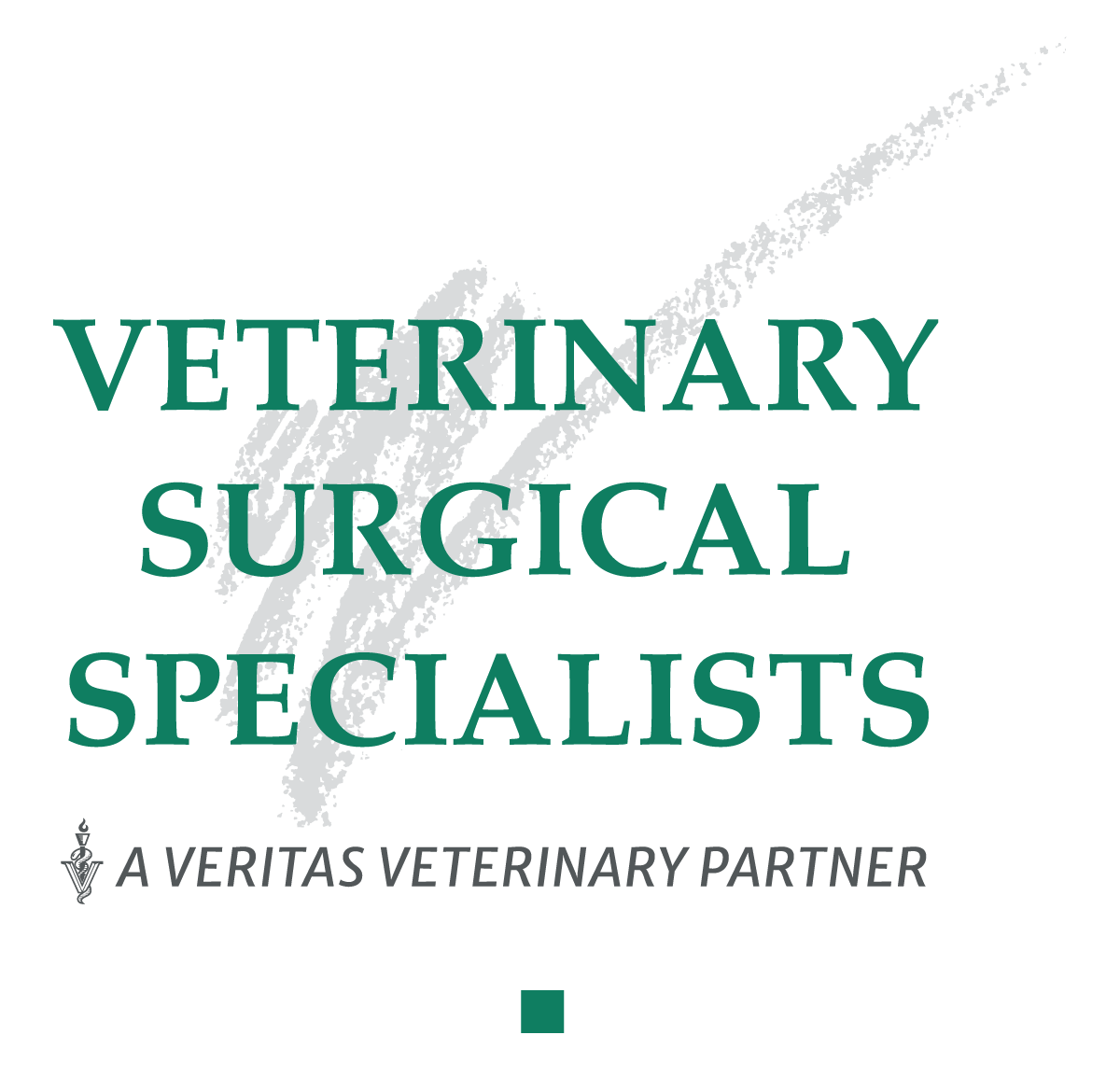When Your Dog Needs Hip Surgery
What is Canine Hip Dysplasia?
Canine Hip Dysplasia (CHD) is a condition where the ‘ball’ and ‘socket’ of the hip joint don’t fit together as they should, causing looseness and instability in the joint that results in a progressive loss of cartilage, the development of scar tissue and bone spurs, and the eventual onset of osteoarthritis.

Several surgical methods exist for treating hip dysplasia in dogs, including:
Juvenile Pubic Symphysiodesis (JPS) is a relatively minor, minimally invasive surgical procedure performed on puppies under 18 weeks of age. JPS closes a growth plate at the bottom of the pelvis to stop the growth of the pubis, which results in the ‘socket’ reshaping to cover the ‘ball’ as the puppy continues to grow post-surgery. Research has shown that the JPS procedure has consistently provided normal, pain-free hip function.
Double or Triple Pelvic Osteotomy (DPO/TPO) has been used successfully in both dogs and children for decades. The DPO/TPO procedure cuts the pelvic bone in two (DPO) or three (TPO) places. The segments are rotated in order to improve the coverage of the ball by the socket.
Total Hip Replacement (THR) is an option for dogs who are at least one year old. Just as in humans, both ball and socket are replaced with implants. Evidence-based studies show this surgery consistently results in normal, pain-free function.
Femoral Head Ostectomy (FHO) Unlike the previous surgeries, the goal of FHO is pain reduction, not normal hip function. In an FHO, the ‘ball’ of the joint is completely removed. Without the ball, the muscles of the hip take over during limb movement. Dogs that undergo FHO are required to stick to a limited exercise program and stay slim. Still, the surgery can provide enough comfort to negate the need for anti-inflammatory pain medication.
It is important to note that the Orthopedic Foundation for Animals (OFA) exam often used by breeders to certify that a dog is free of CHD cannot be performed until a dog is at least 24 months, at which time it is too late in the progression of the disease for some of the most effective surgical options. Because of this, we recommend the PennHIP test be used. PennHIP is a well-researched, peer-reviewed, and objective method that can successfully diagnose puppies as early as 16 weeks.

Why would my pet need CHD surgery?
Left alone, CHD will get progressively worse until your dog can no longer comfortably rise or walk and is in frequent pain. Sadly, in some dogs, this can be as early as a few months old. Medical management can provide some relief for dogs with a sedentary lifestyle, but surgery is the only option for a dog with CHD to live an active, pain-free life.
Symptoms of CHD include:
- Lameness or stiffness of one or both hind legs
- Trouble getting up or going up or downstairs
- Bunny hopping gait
- “Froggy” sit
- Loss of muscle mass on the pelvis and rear limbs
Although there are various factors that contribute to the development of CHD, such as improper nutrition or too little or too much exercise, genetic predisposition is the single most significant risk factor. While smaller dog breeds, such as pugs and French bulldogs, can be affected, the highest risk appears in large and giant breed dogs such as Rottweilers, German Shepherds, Golden and Labrador Retrievers, Great Danes, and Mastiffs as well as others.

What is included with my investment for my pet’s hip surgery at VSS?
Our all-inclusive fee provides:
Pre-op
We include a consultation with one of our board-certified veterinary surgeons to discuss options, determine candidacy for total hip replacement, and all aspects of the procedure, and the owner’s investment required for post-op at-home care. At the initial consultation, our staff will provide an estimate for pre-operation, the procedure, and post-operation, which includes all exams, medications (not refills), recheck appointments, and X-rays for up to one year from date of surgery.
A separate appointment needs to be scheduled for pre-op diagnostic workup within two weeks of the date of surgery. The appointment includes pre-op bloodwork, pre-op urinalysis, and detailed X-rays for surgical planning.
During Surgery
At VSS, your pet’s surgery is performed in a sterile, dedicated surgical environment by the same surgeon you meet with during your initial consult. Medications and anesthesia required by your pet during surgery are included, as well as anesthesia monitoring both during surgery and through recovery by a registered veterinary technician (RVT) who has extensive experience with anesthesia. Our staff will keep you updated on the progress throughout the procedure.
Post-op
Overnight hospitalization is required for most surgeries, although total hip replacement requires three – four nights. You can rest easy knowing that your pet will be monitored 24/7 by a veterinarian and receive necessary antibiotics and pain medication. Additionally, patients are offered a meal when they are alert and will be walked in the afternoon for elimination. While we don’t usually allow visitors due to patient anxiety, we are happy to send photos as requested by the pet parents.
The staff at VSS are available for you to call for updates on your pet any time during their stay with us, 24 hours a day, 7 days a week.
Pain Management
The surgery fee includes all the medications (antibiotics, anti-inflammatory, and pain) your pet needs to come home and be comfortable during their recovery.
Recovery
We will provide a sling to help your furry loved one during their recovery at home. After his or her surgery, your dog will need to be confined to a small rest area for two weeks, with limited walks only while on a leash with support from the sling. For two to six weeks, we recommend all patients go on short walks on a leash and continue to be confined indoors when unattended. These types of measures at home will ensure a successful and speedy recovery.
Follow-up
Post-surgery appointments to check on the status of your pet are also included and vary depending on the surgery. Total hip replacement follow-up appointments include a suture removal at two weeks and then a round of recheck X-rays at six weeks, three months, and nine months. All of the above routine recheck appointments are included with the surgery.

Why choose VSS for your pet’s procedure?

At VSS, all we do is perform advanced, technical surgeries every day our state-of-the-art facility. Our board-certified veterinary surgeons have trained at some of the most prestigious veterinary teaching hospitals in the country, and are leaders in the field of orthopedic surgery, with over 70 years of combined surgical experience.
Additionally, VSS is Southern California’s premier animal surgical hospital and one of the first specialty hospitals to receive an Accredited Referral Practice designation, which means over 900 quality standards of our practice are consistently evaluated by the American Animal Hospital Association (AAHA). Unlike human hospitals, accreditation for a veterinary hospital is voluntary. Rest assured, we hold ourselves to that higher standard every day.
But all that means nothing without the compassion and dedication to service from our highly trained and experienced team members. In short, you can expect the best from VSS from the very start.
For more information or to be contacted by a VSS team member for a consultation, fill out the form below.
